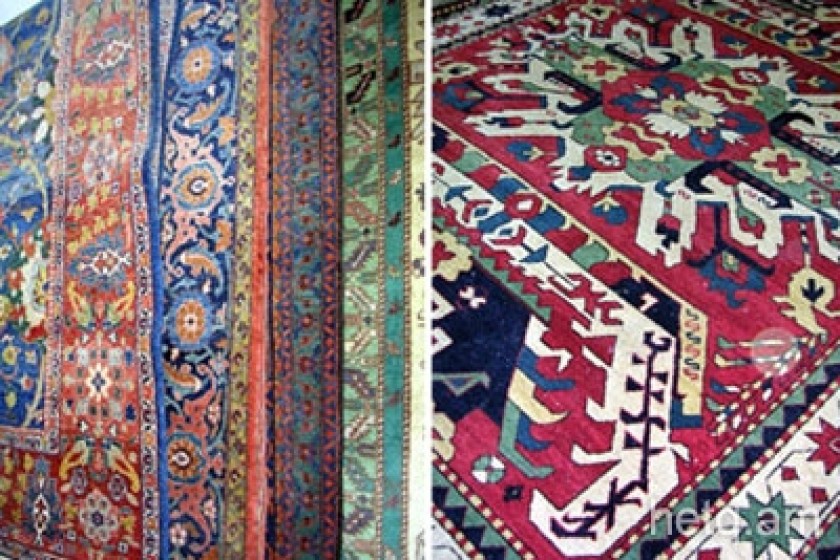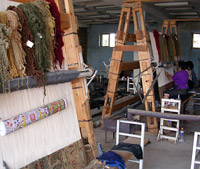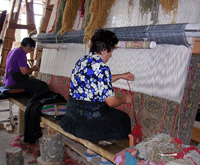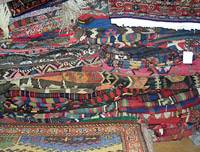
Carpet Weaving in Armenia
Armenian Carpet Prices Rise by 40% on the International Market
The director of one of the few carpet-weaving units inArmenia, Mkhitar Simonyan, said that carpet weaving was on the verge of extinction inArmenia. Aida Simonyan ltd., owned by the Simonyan brothers, is located in the GegharkunikvillageofChambarak. The unit has 150 workers, but they only manage to gather around 40 carpet weavers, and that too only in the winter when people come to work there just because they have nothing else to do.
In the summer, they prefer to cultivate land and raise animals. A carpet weaver’s average monthly salary is 30,000 drams. There are virtually no other jobs in Chambarak.
“We are unable to promote carpet weaving. There are tens of unemployed women in Chambarak who can weave carpets, but they don’t come here to work. We cannot pay them enough to motivate them to come and not regret investing their time in this work,” said the company director Mkhitar Simonyan.
This carpet weaving unit opened in 2006, but has only managed to get by and is on the verge of closing, according to management. Their main client is Tufenkian Trans Caucasus, which exports 90 percent of its carpets to the United States and sells the remaining 10 percent in Yerevan, where the buyers are exclusively foreigners. Because of fluctuations in the dollar-dram exchange rate, the exporting company raised prices by 40 percent. The dollars brought in from carpet sales abroad were no longer enough to cover the expenses accrued in drams locally. The cost price of each carpet was higher than its selling price. Prices for other carpets in the international market have been quite stable over the past several years, while Armenian carpets have grown more expensive by 40-50 percent.
“The foreign market is flooded with carpets - cheap, expensive, good quality, bad quality - all kinds. If the buyer does not decide to buy Armenian carpets specifically, then they can find other carpets of the same quality but at a cheaper price. How can we compete? The client does not agree with the price we set, but we have no other choice. We have to either raise prices or shut down. But if we raise prices we may end up without clients and have to close down anyway,” concluded the unit director.
That is what happened to Sahakyan Carpets, founded in the 1990s, which sold its equipment to Tufenkian Trans Caucasus and left the market once and for all in 2005. A number of other small carpet-weaving units were dealt the same fate. Tufenkian Trans Caucasus has been operating in Armenia since 1994. Three units continue to work in Armenia thanks to orders from this company - one each in the villages of Chambarak, Lchashen and Karmir. These units do not have other clients. The carpets are all hand-woven. They are brought to a central office in Yerevan from the units, where they undergo final processing and are the exported to the United States, where they are sold in shops in a number of places - Dallas, Chicago, New York and California.
 |
 |
 |
Arman Grigoryan, director-in-chief of Tufenkian Trans Caucasus, noted that carpet sales by the company had halved over the past three years. “We would produce and export around 800-900 sq m on a monthly basis two or three years ago, sometimes even 1000 sq m. Now the volume of our production and export is about half of that. Now we produce and export around 300-400 sq m a month,” said Arman Grigoryan.
Tufenkian Trans Caucasus is looking for ways to lower the cost price of carpets. They are searching for new suppliers are importers of wool and thread. “We used to think earlier that we should buy wool yarn from our villagers, but that would be a luxury for us now,” said Grigoryan. Mkhitar Simonyan, the director of the Chambarak carpet-weaving unit, was confident that they could produce carpets by themselves in a condition ready for sale, but that they could never succeed in selling them abroad. “Our carpets sell abroad because they bear the Tufenkian brand. We and others like us can’t break into the international market and sell our carpets at even half the cost price,” said Simonyan.
 |
 |
 |
| Mkhitar Simonyan | Arman Grigoryan | Irina Ghalechyan |
Carpet Weavers of Artsvashen Jobless
The carpet weavers of Chambarak are mainly women who migrated there in 1992 from Artsvashen. During the Soviet period, there used to be a branch of Haygorg, the state carpet company, in Artsvashen. After the collapse of the Soviet Unionand the invasion of the Azeris, the residents of Artsvashen migrated to Chambarak, Vardenis and Abovyan. The two-story Haygorg building was torn down and the storeroom, full of hundreds of carpets, was ransacked. The women of Artsvashen learned carpet weaving from their mothers and grandmothers. Many of them had worked for Haygorg for decades. “It was shameful for a girl or woman in Artsvashen not to be able to weave carpets. Even if they didn’t work for Haygorg, they would have a weaving stand at home and make carpets,” said Irina Ghalechyan, a former resident of Artsvashen and carpet weaver.
In 1992, the people of Artsvashen left all they had and moved to the area in Armenia closest to them, the village of Chambarak. They came with the hope that they would be able to return in three days, but they have remained for 15 years. “Haygorg was operating until the very last day. When they would start shooting we would hide in the basement. As soon as the shooting would stop, we would get out, get to our work stations and continue weaving,” said Irina. When the village was lost, there were around 750 households or 3,000 residents there. The government gave loans to the people of Artsvashen, with which they bought the houses of the Molokans in Chambarak.
“People used to really value carpets before… A carpet used to be like an open book in ancient times, it used to have real meaning. Now it is just a thing of beauty and wealth. Carpets used to tell stories, but not everyone could read them. My ancestors used to weave from memory. A long time ago, people would pay in gold for the carpets of Artsvashen, even though many of them were woven by illiterate women,” said Irina. Very few women from Artsvashen work in the carpet-weaving unit at Chambarak. They prefer to work in fields or orchards; carpet weaving is no longer a means to make a living. These women no longer want their daughters to learn carpet weaving.
One of the characteristic features of Armenian carpets is their symbolic representation of the sun, stars, animals, plants, people, dragons, birds and snakes. This is in contrast to Arabian, Persian or Turkish carpets where they are represented as they are, without symbolic patterns.
“In the old days, people would hang carpets on the wall. That’s how it would be in almost all houses. Carpets had the same significance to Armenians that icons had for the Orthodox Church. Carpets were considered sacred. My ancestors believed that a carpet could bring success and prosperity to the house. Obviously, one couldn’t put a carpet like that on the floor or table. They would weave carpets for the floor which would not have any symbols representing God or light. But they would not hang carpets on every wall. They would leave it for the main wall of the house, where they would also hang their guns and pictures of their ancestors,” said Irina.
One of the best-known symbols on Armenian carpets represents the Dragon. Carpets with dragons on them are called vishapagorg, or Dragon Carpets. The Dragon is not considered good or evil in Armenian symbology; it is an element that can be both good and inexorably evil. The Dragon is considered a protective symbol for the home. Dragons are woven into the edges of a carpet but never in its center. This is to say that dragons protect the edges of the world, but the center is almost always occupied by the Sun.
“Our grandfather dealt in the trade of ancient carpets his whole life. He used to say that a cow, a silver belt and a carpet were all equal as riches and held the same value. In my grandfather’s time, women used to weave carpets from memory, which is why each carpet was an irreproducible piece of art. Now, even if the carpets are hand-woven, they are mass produced and are all the same because the women look at pictures to weave them,” said Mkhitar Simonyan.
Armenian carpets used to have different names in the past - Vishapagorg, Tavriz, Bayazet, Vaspurakan, Tzaragorg, Zangezur, Gharabagh, Dvin, Shirak, Lori, Taron, Ani - according to corresponding patterns and places. Now, carpets no longer have names, they are just given numbers.
“In the 90s, many Armenians sold the carpets that they had for pennies. We lost a part of the history of our art in that way,” said carpet weaver Irina Ghalechyan.
 Videos
Videos Photos
Photos
Write a comment